CHEVROLET AVALANCHE 2007 2.G Owners Manual
Manufacturer: CHEVROLET, Model Year: 2007, Model line: AVALANCHE, Model: CHEVROLET AVALANCHE 2007 2.GPages: 618, PDF Size: 3.25 MB
Page 421 of 618
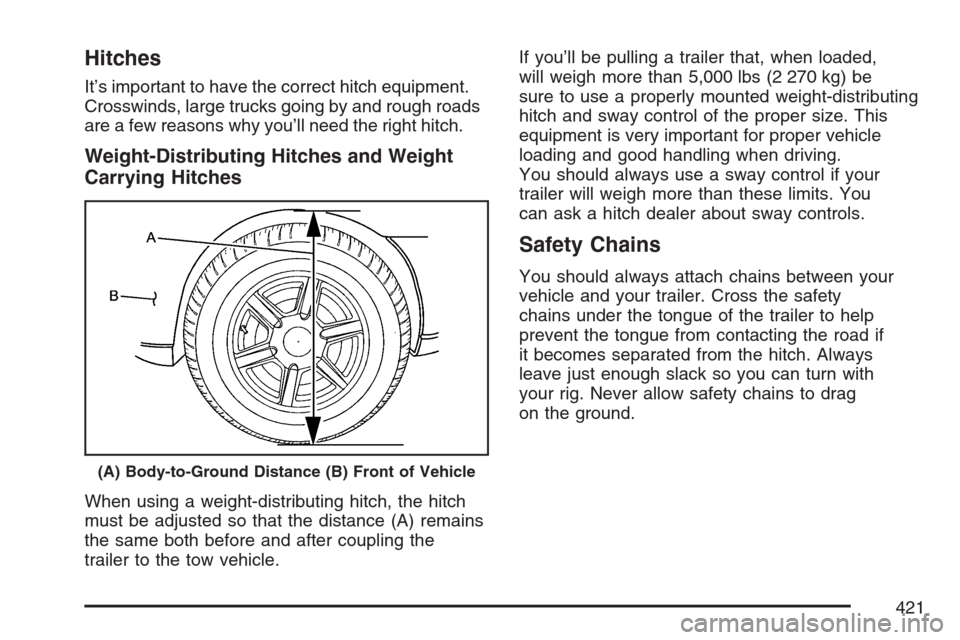
Hitches
It’s important to have the correct hitch equipment.
Crosswinds, large trucks going by and rough roads
are a few reasons why you’ll need the right hitch.
Weight-Distributing Hitches and Weight
Carrying Hitches
When using a weight-distributing hitch, the hitch
must be adjusted so that the distance (A) remains
the same both before and after coupling the
trailer to the tow vehicle.If you’ll be pulling a trailer that, when loaded,
will weigh more than 5,000 lbs (2 270 kg) be
sure to use a properly mounted weight-distributing
hitch and sway control of the proper size. This
equipment is very important for proper vehicle
loading and good handling when driving.
You should always use a sway control if your
trailer will weigh more than these limits. You
can ask a hitch dealer about sway controls.
Safety Chains
You should always attach chains between your
vehicle and your trailer. Cross the safety
chains under the tongue of the trailer to help
prevent the tongue from contacting the road if
it becomes separated from the hitch. Always
leave just enough slack so you can turn with
your rig. Never allow safety chains to drag
on the ground.
(A) Body-to-Ground Distance (B) Front of Vehicle
421
Page 422 of 618
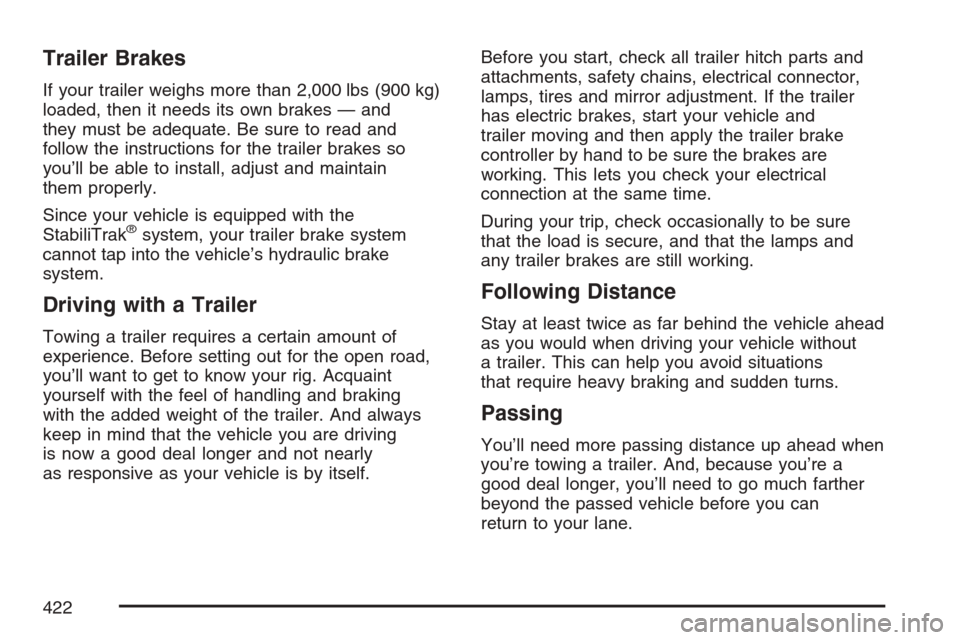
Trailer Brakes
If your trailer weighs more than 2,000 lbs (900 kg)
loaded, then it needs its own brakes — and
they must be adequate. Be sure to read and
follow the instructions for the trailer brakes so
you’ll be able to install, adjust and maintain
them properly.
Since your vehicle is equipped with the
StabiliTrak
®system, your trailer brake system
cannot tap into the vehicle’s hydraulic brake
system.
Driving with a Trailer
Towing a trailer requires a certain amount of
experience. Before setting out for the open road,
you’ll want to get to know your rig. Acquaint
yourself with the feel of handling and braking
with the added weight of the trailer. And always
keep in mind that the vehicle you are driving
is now a good deal longer and not nearly
as responsive as your vehicle is by itself.Before you start, check all trailer hitch parts and
attachments, safety chains, electrical connector,
lamps, tires and mirror adjustment. If the trailer
has electric brakes, start your vehicle and
trailer moving and then apply the trailer brake
controller by hand to be sure the brakes are
working. This lets you check your electrical
connection at the same time.
During your trip, check occasionally to be sure
that the load is secure, and that the lamps and
any trailer brakes are still working.
Following Distance
Stay at least twice as far behind the vehicle ahead
as you would when driving your vehicle without
a trailer. This can help you avoid situations
that require heavy braking and sudden turns.
Passing
You’ll need more passing distance up ahead when
you’re towing a trailer. And, because you’re a
good deal longer, you’ll need to go much farther
beyond the passed vehicle before you can
return to your lane.
422
Page 423 of 618
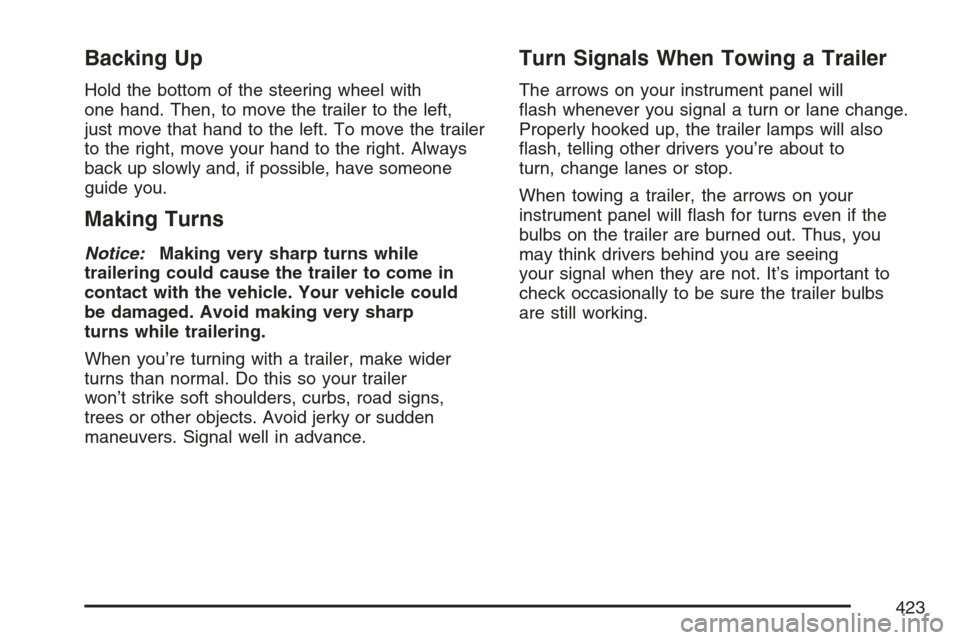
Backing Up
Hold the bottom of the steering wheel with
one hand. Then, to move the trailer to the left,
just move that hand to the left. To move the trailer
to the right, move your hand to the right. Always
back up slowly and, if possible, have someone
guide you.
Making Turns
Notice:Making very sharp turns while
trailering could cause the trailer to come in
contact with the vehicle. Your vehicle could
be damaged. Avoid making very sharp
turns while trailering.
When you’re turning with a trailer, make wider
turns than normal. Do this so your trailer
won’t strike soft shoulders, curbs, road signs,
trees or other objects. Avoid jerky or sudden
maneuvers. Signal well in advance.
Turn Signals When Towing a Trailer
The arrows on your instrument panel will
�ash whenever you signal a turn or lane change.
Properly hooked up, the trailer lamps will also
�ash, telling other drivers you’re about to
turn, change lanes or stop.
When towing a trailer, the arrows on your
instrument panel will �ash for turns even if the
bulbs on the trailer are burned out. Thus, you
may think drivers behind you are seeing
your signal when they are not. It’s important to
check occasionally to be sure the trailer bulbs
are still working.
423
Page 424 of 618
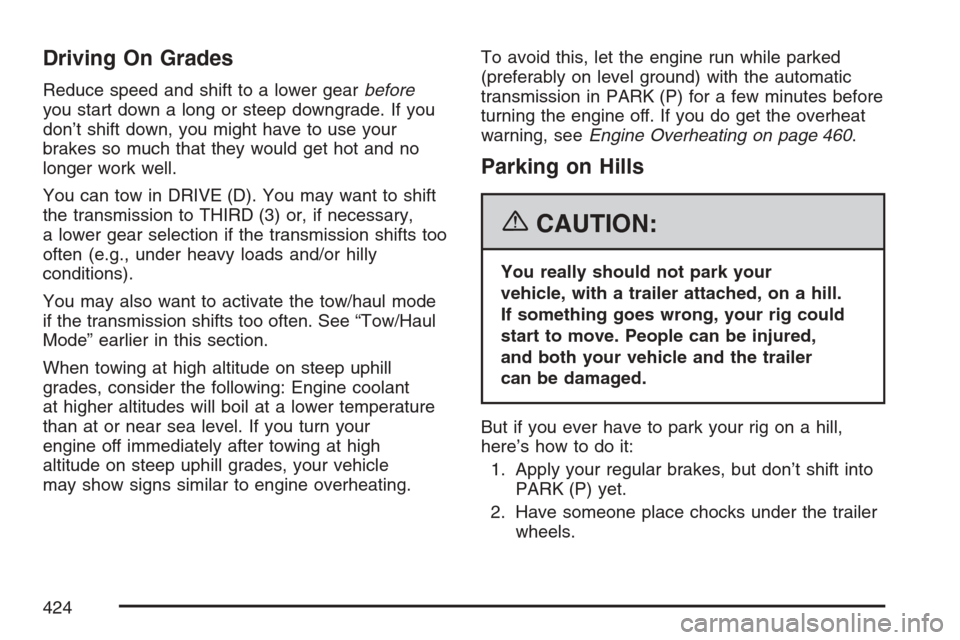
Driving On Grades
Reduce speed and shift to a lower gearbefore
you start down a long or steep downgrade. If you
don’t shift down, you might have to use your
brakes so much that they would get hot and no
longer work well.
You can tow in DRIVE (D). You may want to shift
the transmission to THIRD (3) or, if necessary,
a lower gear selection if the transmission shifts too
often (e.g., under heavy loads and/or hilly
conditions).
You may also want to activate the tow/haul mode
if the transmission shifts too often. See “Tow/Haul
Mode” earlier in this section.
When towing at high altitude on steep uphill
grades, consider the following: Engine coolant
at higher altitudes will boil at a lower temperature
than at or near sea level. If you turn your
engine off immediately after towing at high
altitude on steep uphill grades, your vehicle
may show signs similar to engine overheating.To avoid this, let the engine run while parked
(preferably on level ground) with the automatic
transmission in PARK (P) for a few minutes before
turning the engine off. If you do get the overheat
warning, seeEngine Overheating on page 460.
Parking on Hills
{CAUTION:
You really should not park your
vehicle, with a trailer attached, on a hill.
If something goes wrong, your rig could
start to move. People can be injured,
and both your vehicle and the trailer
can be damaged.
But if you ever have to park your rig on a hill,
here’s how to do it:
1. Apply your regular brakes, but don’t shift into
PARK (P) yet.
2. Have someone place chocks under the trailer
wheels.
424
Page 425 of 618
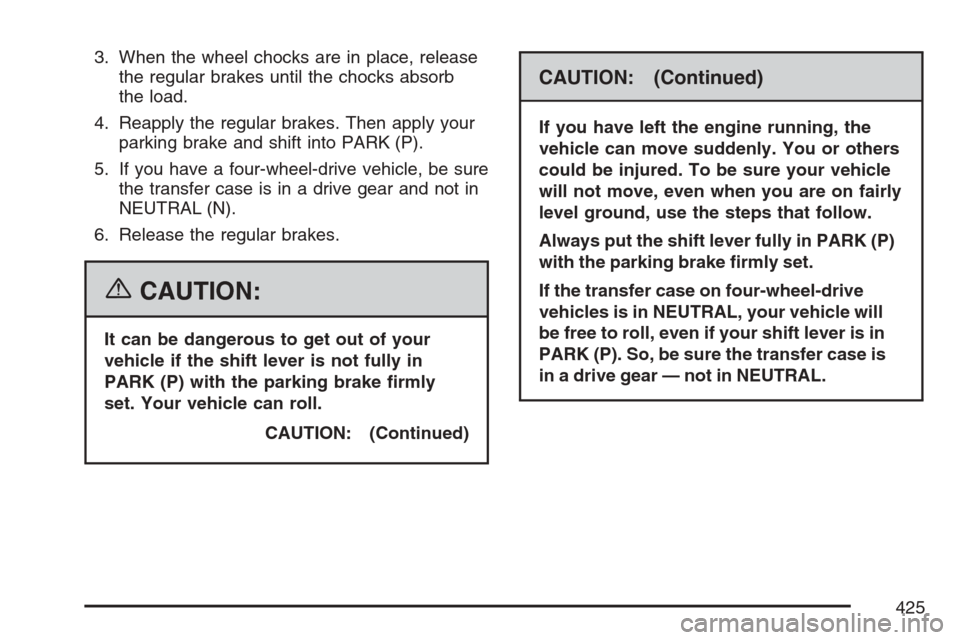
3. When the wheel chocks are in place, release
the regular brakes until the chocks absorb
the load.
4. Reapply the regular brakes. Then apply your
parking brake and shift into PARK (P).
5. If you have a four-wheel-drive vehicle, be sure
the transfer case is in a drive gear and not in
NEUTRAL (N).
6. Release the regular brakes.
{CAUTION:
It can be dangerous to get out of your
vehicle if the shift lever is not fully in
PARK (P) with the parking brake �rmly
set. Your vehicle can roll.
CAUTION: (Continued)
CAUTION: (Continued)
If you have left the engine running, the
vehicle can move suddenly. You or others
could be injured. To be sure your vehicle
will not move, even when you are on fairly
level ground, use the steps that follow.
Always put the shift lever fully in PARK (P)
with the parking brake �rmly set.
If the transfer case on four-wheel-drive
vehicles is in NEUTRAL, your vehicle will
be free to roll, even if your shift lever is in
PARK (P). So, be sure the transfer case is
in a drive gear — not in NEUTRAL.
425
Page 426 of 618
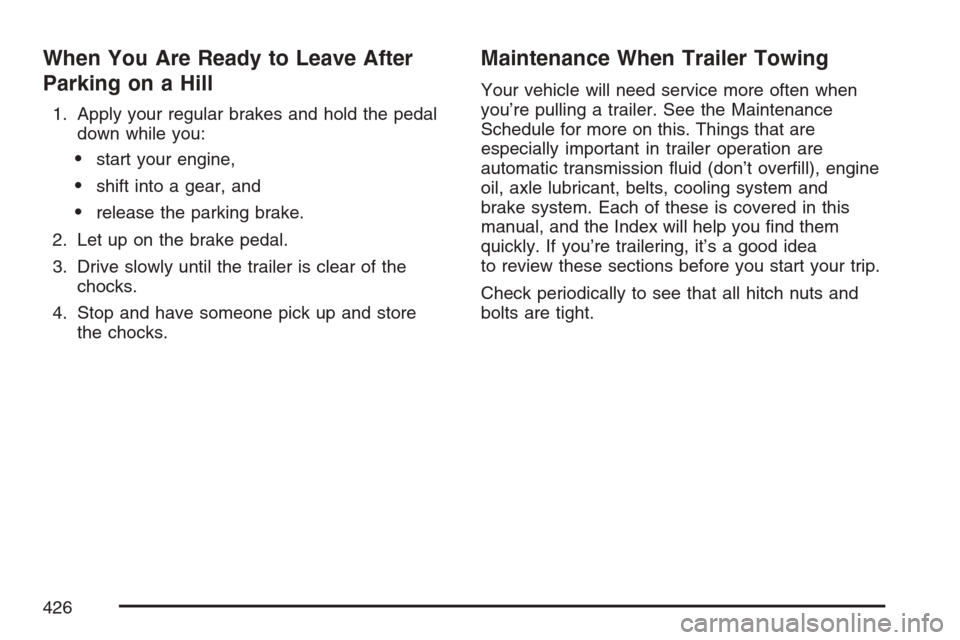
When You Are Ready to Leave After
Parking on a Hill
1. Apply your regular brakes and hold the pedal
down while you:
start your engine,
shift into a gear, and
release the parking brake.
2. Let up on the brake pedal.
3. Drive slowly until the trailer is clear of the
chocks.
4. Stop and have someone pick up and store
the chocks.
Maintenance When Trailer Towing
Your vehicle will need service more often when
you’re pulling a trailer. See the Maintenance
Schedule for more on this. Things that are
especially important in trailer operation are
automatic transmission �uid (don’t over�ll), engine
oil, axle lubricant, belts, cooling system and
brake system. Each of these is covered in this
manual, and the Index will help you �nd them
quickly. If you’re trailering, it’s a good idea
to review these sections before you start your trip.
Check periodically to see that all hitch nuts and
bolts are tight.
426
Page 427 of 618
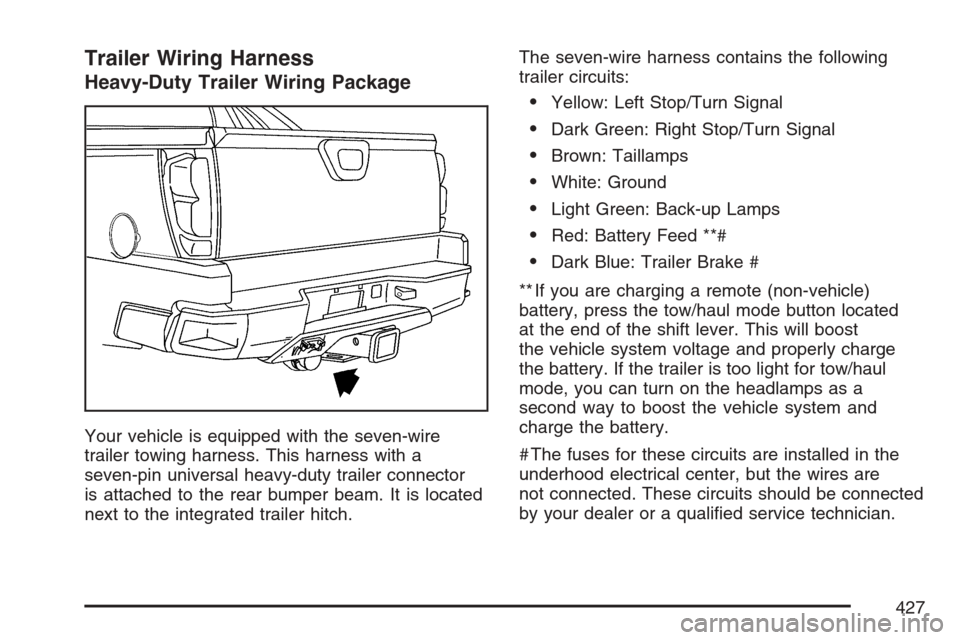
Trailer Wiring Harness
Heavy-Duty Trailer Wiring Package
Your vehicle is equipped with the seven-wire
trailer towing harness. This harness with a
seven-pin universal heavy-duty trailer connector
is attached to the rear bumper beam. It is located
next to the integrated trailer hitch.The seven-wire harness contains the following
trailer circuits:
Yellow: Left Stop/Turn Signal
Dark Green: Right Stop/Turn Signal
Brown: Taillamps
White: Ground
Light Green: Back-up Lamps
Red: Battery Feed **#
Dark Blue: Trailer Brake #
** If you are charging a remote (non-vehicle)
battery, press the tow/haul mode button located
at the end of the shift lever. This will boost
the vehicle system voltage and properly charge
the battery. If the trailer is too light for tow/haul
mode, you can turn on the headlamps as a
second way to boost the vehicle system and
charge the battery.
# The fuses for these circuits are installed in the
underhood electrical center, but the wires are
not connected. These circuits should be connected
by your dealer or a quali�ed service technician.
427
Page 428 of 618
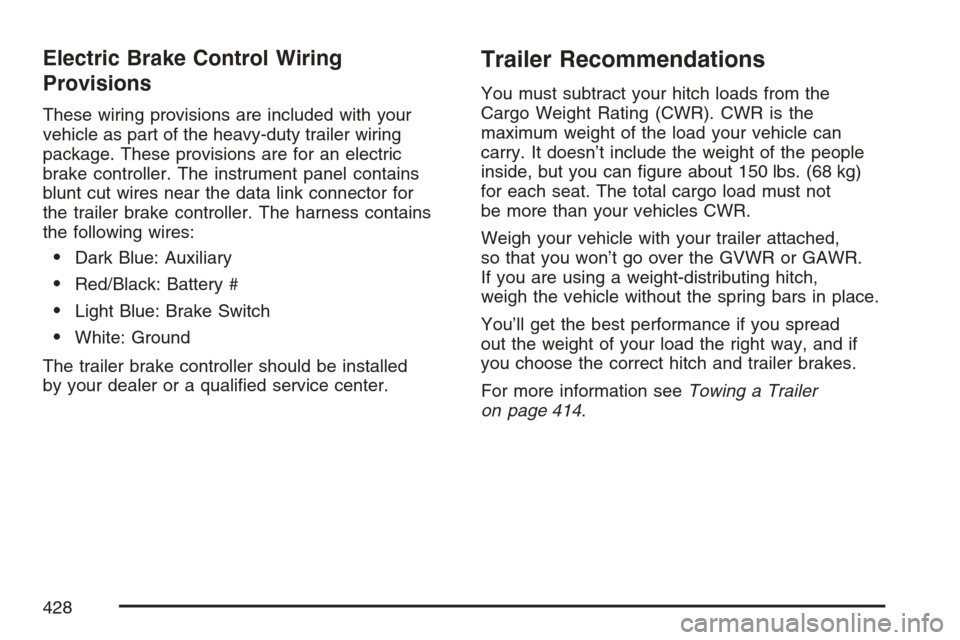
Electric Brake Control Wiring
Provisions
These wiring provisions are included with your
vehicle as part of the heavy-duty trailer wiring
package. These provisions are for an electric
brake controller. The instrument panel contains
blunt cut wires near the data link connector for
the trailer brake controller. The harness contains
the following wires:
Dark Blue: Auxiliary
Red/Black: Battery #
Light Blue: Brake Switch
White: Ground
The trailer brake controller should be installed
by your dealer or a quali�ed service center.
Trailer Recommendations
You must subtract your hitch loads from the
Cargo Weight Rating (CWR). CWR is the
maximum weight of the load your vehicle can
carry. It doesn’t include the weight of the people
inside, but you can �gure about 150 lbs. (68 kg)
for each seat. The total cargo load must not
be more than your vehicles CWR.
Weigh your vehicle with your trailer attached,
so that you won’t go over the GVWR or GAWR.
If you are using a weight-distributing hitch,
weigh the vehicle without the spring bars in place.
You’ll get the best performance if you spread
out the weight of your load the right way, and if
you choose the correct hitch and trailer brakes.
For more information seeTowing a Trailer
on page 414.
428
Page 429 of 618
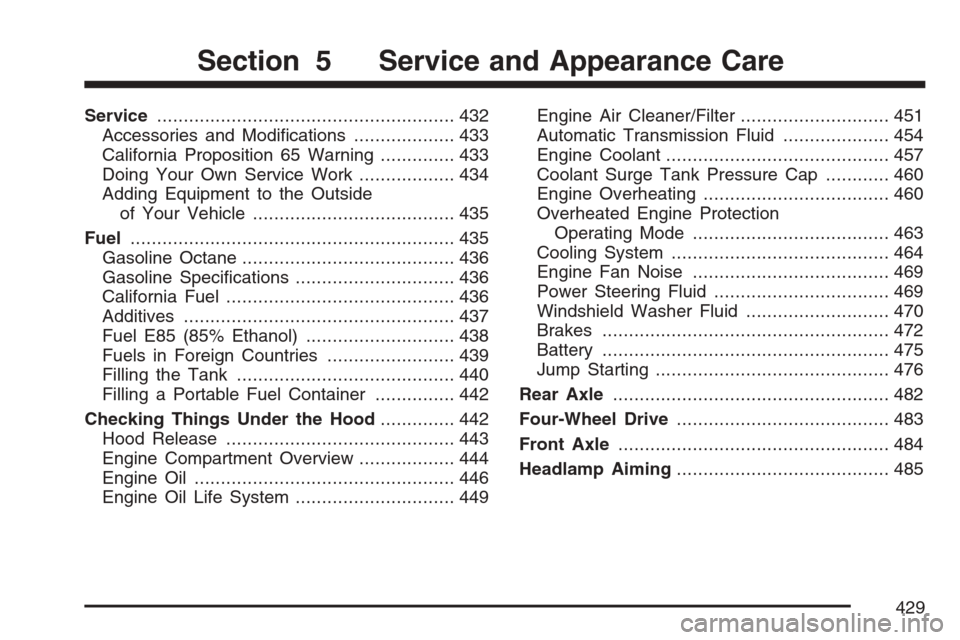
Service........................................................ 432
Accessories and Modi�cations................... 433
California Proposition 65 Warning.............. 433
Doing Your Own Service Work.................. 434
Adding Equipment to the Outside
of Your Vehicle...................................... 435
Fuel............................................................. 435
Gasoline Octane........................................ 436
Gasoline Speci�cations.............................. 436
California Fuel........................................... 436
Additives................................................... 437
Fuel E85 (85% Ethanol)............................ 438
Fuels in Foreign Countries........................ 439
Filling the Tank......................................... 440
Filling a Portable Fuel Container............... 442
Checking Things Under the Hood.............. 442
Hood Release........................................... 443
Engine Compartment Overview.................. 444
Engine Oil................................................. 446
Engine Oil Life System.............................. 449Engine Air Cleaner/Filter............................ 451
Automatic Transmission Fluid.................... 454
Engine Coolant.......................................... 457
Coolant Surge Tank Pressure Cap............ 460
Engine Overheating................................... 460
Overheated Engine Protection
Operating Mode..................................... 463
Cooling System......................................... 464
Engine Fan Noise..................................... 469
Power Steering Fluid ................................. 469
Windshield Washer Fluid........................... 470
Brakes...................................................... 472
Battery...................................................... 475
Jump Starting............................................ 476
Rear Axle.................................................... 482
Four-Wheel Drive........................................ 483
Front Axle................................................... 484
Headlamp Aiming........................................ 485
Section 5 Service and Appearance Care
429
Page 430 of 618
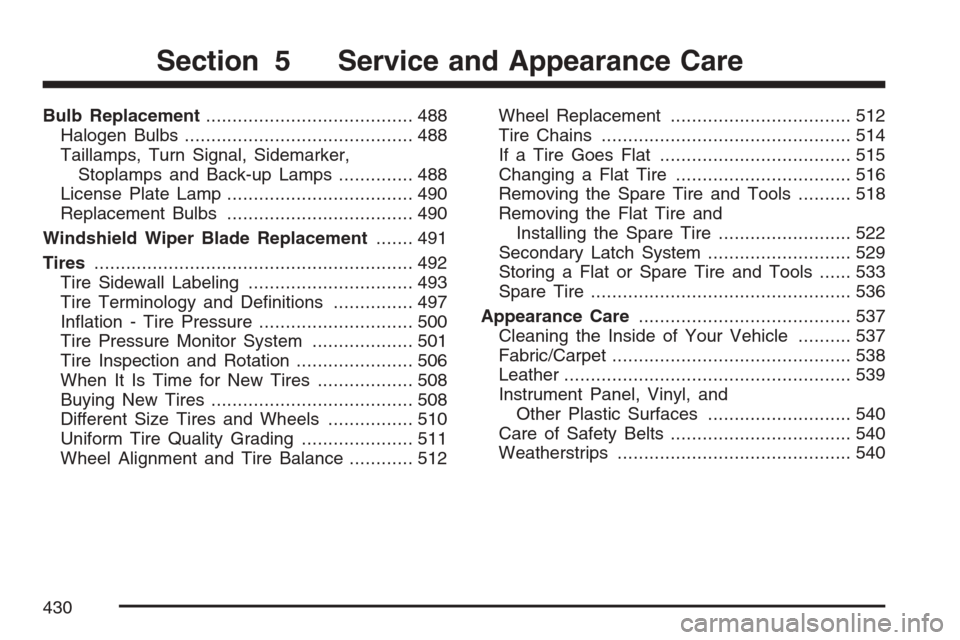
Bulb Replacement....................................... 488
Halogen Bulbs........................................... 488
Taillamps, Turn Signal, Sidemarker,
Stoplamps and Back-up Lamps.............. 488
License Plate Lamp................................... 490
Replacement Bulbs................................... 490
Windshield Wiper Blade Replacement....... 491
Tires............................................................ 492
Tire Sidewall Labeling............................... 493
Tire Terminology and De�nitions............... 497
In�ation - Tire Pressure............................. 500
Tire Pressure Monitor System................... 501
Tire Inspection and Rotation...................... 506
When It Is Time for New Tires.................. 508
Buying New Tires...................................... 508
Different Size Tires and Wheels................ 510
Uniform Tire Quality Grading..................... 511
Wheel Alignment and Tire Balance............ 512Wheel Replacement.................................. 512
Tire Chains............................................... 514
If a Tire Goes Flat.................................... 515
Changing a Flat Tire................................. 516
Removing the Spare Tire and Tools.......... 518
Removing the Flat Tire and
Installing the Spare Tire......................... 522
Secondary Latch System........................... 529
Storing a Flat or Spare Tire and Tools...... 533
Spare Tire................................................. 536
Appearance Care........................................ 537
Cleaning the Inside of Your Vehicle.......... 537
Fabric/Carpet............................................. 538
Leather...................................................... 539
Instrument Panel, Vinyl, and
Other Plastic Surfaces........................... 540
Care of Safety Belts.................................. 540
Weatherstrips............................................ 540
Section 5 Service and Appearance Care
430